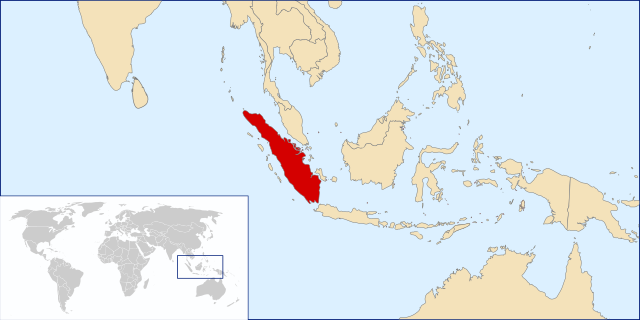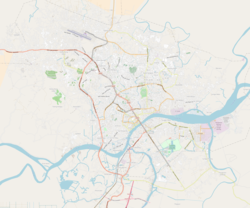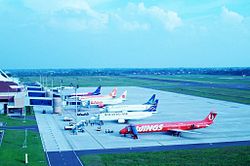Top Qs
Timeline
Chat
Perspective
Sultan Mahmud Badaruddin II International Airport
Airport serving Palembang, South Sumatra, Indonesia From Wikipedia, the free encyclopedia
Remove ads
Sultan Mahmud Badaruddin II International Airport (IATA: PLM, ICAO: WIPP) is an airport serving the city of Palembang, South Sumatra, Indonesia, and surrounding areas. The airport is located 10 km from Palembang's city center, in the Talang Betutu district. Previously known as Talang Betutu Airport, it was renamed in honor of Sultan Mahmud Badaruddin II (1767–1852), the last sultan of Palembang and a revered national hero of Indonesia. The airport is the primary gateway to Palembang and South Sumatra, offering flights to key cities across Indonesia, including Jakarta, Surabaya, Medan, and Yogyakarta. The airport previously offered international flights to Kuala Lumpur, Malaysia, and Singapore. However, these services were suspended during the COVID-19 pandemic, and in 2024, the airport's international status was temporarily revoked due to the absence of international flights.[3] The status was reinstated the following year.[4]
In addition of handling commercial/general aviation flights, the airport also hosts the Sri Mulyono Herlambang Air Force Base, a Type B class facility of the Indonesian Air Force. The airbase is situated directly across the runway from the passenger terminal. This airbase would usually host the annual Super Garuda Shield military exercise that is conducted yearly between Indonesia and the United States.
Remove ads
History
Summarize
Perspective
Long before Indonesia's independence, in 1920, the land that now houses Sultan Mahmud Badaruddin II Airport was an empty plot, once part of a native plantation. At that time, the Dutch East Indies government acquired the land through the Palembang Maatschappij. Around the same period, a Dutch pilot was reported to be flying to Indonesia and intended to land in Palembang. The former plantation land was then transformed into the city's first airfield, known as Talang Betutu Airport. The Dutch pilot, Jan Pieterszoon, subsequently landed a small Fokker plane from Europe in Palembang.[5]
The airport played a crucial role in the war efforts during World War II. In January 1942, the American-British-Dutch-Australian Command (ABDACOM) decided to consolidate Allied air forces in Sumatra, establishing two key airfields near Palembang: Pangkalan Benteng, also known as 'P1' (the current airport), and a secret airbase at Prabumulih (then Praboemoelih), referred to as 'P2.'[6] The airport was a significant strategic asset for both the Allies and the Japanese, who considered it a primary target alongside the Royal Dutch Shell oil refineries at Pladju (Pladjoe), located just miles from Palembang. The Japanese viewed the airport as essential for reinforcing and resupplying their forces, and as a base for further advancing into northern Sumatra and Java.[6] In February 1942, during the Battle of Palembang, Japanese forces captured the airport as part of their broader invasion of the Dutch East Indies.[6] Following their takeover, the Imperial Japanese Army rebuilt the airport between 1942 and 1943.
On January 1, 1950, following Indonesia's independence, Talang Betutu Airport was opened for civilian use, serving as a gateway to the region by air. The airport was later renamed Sultan Mahmud Badaruddin II International Airport. The name was chosen in honor of the Indonesian hero Sultan Mahmud Badaruddin II, who led the Sultanate of Palembang Darussalam from 1803 to 1819. During his leadership, Badaruddin II played a pivotal role in resisting the Dutch East India Company (VOC), which was invading Palembang at the time.[5]
Effective April 1, 1991, the airport is officially managed by the Management of Perum Angkasa Pura II. On January 2, 1992, Management Perum Angkasa Pura II changed its status into PT (Persero) Angkasa Pura II.
When South Sumatra Province was chosen as the host of PON XVI in 2004, the government sought to enlarge the capacity of the airport as well as change the status into an international airport. The current terminal building of the airport was inaugurated on September 27, 2005. The airport was expanded again in 2017 to accommodate the 2018 Asian Games.
In 2024, the Indonesian Ministry of Transportation briefly revoked the airport's international status due to the absence of international flights; however, it was reinstated in 2025.[7][4]
Remove ads
Facilities and development
Summarize
Perspective
Following its development, the airport became an international hub capable of accommodating wide-body aircraft as of September 27, 2005. The development project began on September 18, 2003, with a total cost of Rp. 366.7 billion, funded by a loan from the Japan International Bank for Reconstruction and Development (JIBIC) amounting to Rp. 251.9 billion, and matching funds from the state budget totaling Rp. 114.8 billion.[5] The project included an extension of the runway from 300 meters by 60 meters to 3,000 meters by 60 meters, as well as the construction of a 20,000-square-meter parking area with capacity for 1,000 vehicles. Additionally, a three-floor passenger terminal was built, spanning 13,000 square meters and capable of accommodating 1,250 passengers. The airport also features equipped aerobridges, a cargo terminal, and various support buildings covering an area of 1,900 square meters. As a result of this expansion, Sultan Mahmud Badaruddin II International Airport can now accommodate aircraft such as the Airbus A330, Boeing 747, Boeing 777, and other wide-body models.[5]
The airport was developed once again for 2018 Asian Games, which started in late 2016 and finished by 2017.[8] Passenger capacity of the terminal, which has a capacity of 3.4 million passengers per year, increased to 4 million passengers and check in counters increased to 43. The aircraft parking apron can accommodate 19 aircraft.[9] The terminal area was expanded from 34,000 square meters to 115,000 square meters. Passenger capacity of the airport will be gradually increase to accommodate 9 million passengers annually.[10]
Remove ads
Airlines and destinations
Passenger
Traffic and statistics
Summarize
Perspective

Traffic
Statistics
Remove ads
Ground transportation
Summarize
Perspective
Bus
DAMRI intercity buses operate from the airport, providing connections to various cities in South Sumatra, including Baturaja, Prabumulih, and Muara Enim.[19]
Taxi
Various taxi services are available at Sultan Mahmud Badaruddin II International Airport to transport passengers to destinations in Palembang and nearby cities. Official airport taxi operators include Balido Taxi, Blue Bird, Primkopau Taxi, and Starcab Taxi. The initial fare (flag fall) is Rp 7,000, with an additional charge of Rp 5,000 per kilometer. These taxi services operate 24 hours a day. In addition, passengers can also opt for ride-hailing services such as Grab and Gojek. Fares for these online taxis vary depending on the travel distance.[20]
Rail
Anticipating traffic congestion during the period of 2018 Asian Games, the local government built the Palembang Light Rail Transit, which connects the airport to Jakabaring Sport City.[21] Only some of the stations were opened in time for the games. The remaining stations opened on 18 October 2017.[22] It is the first practical modern light rapid system to operate in Indonesia.
The Sultan Mahmud Badaruddin II International Airport LRT station serves the airport, which is connected to the airport terminal by a skybridfe. The LRT's fare separates passengers who ride to and from the airport and those who do not, with the former paying a higher fare of Rp 10,000 while the latter pay Rp 5,000.[23]
Remove ads
Gallery
- A Batik Air Airbus A320 landing in Sultan Mahmud Badaruddin II International Airport
- View of the airport in 2006
Accidents and incidents
- October 6, 1937 - The KLM Douglas DC-3, named "Specht" with registration PH-ALS from Palembang to Singapore, crashed immediately after takeoff at Palembang Airport, Netherlands East Indies. Three crew members and one passenger died. The co-pilot and seven passengers survived. A connecting rod in the No. 1 engine had failed, causing a fuel-fed fire. The pilot cut the fuel flow to the engine, but the aircraft was unable to gain height on one engine, leading to its crash.[24]
- On September 24, 1975, Garuda Indonesia Flight 150 crashed on approach to Talang Betutu Airport. The accident, which was attributed to poor weather and fog, killed 25 of the 61 passengers and one person on the ground.[25]
Remove ads
Notes
References
External links
Wikiwand - on
Seamless Wikipedia browsing. On steroids.
Remove ads








